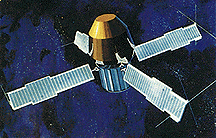Satellite Showcase
The Second Small Astronomical Satellite (SAS-2)

The Mission
The second NASA Small Astronomy Satellite (SAS-2) was dedicated to
gamma-ray
astronomy in the
energy range above 35 MeV. The
satellite
carried a single experiment. It spun so that the spin axis was the same as
the telescope axis. SAS-2 was launched on 15 November 1972. Data collection
stopped on 8 June 1873 when a power supply failed.
The low fluxes involved in the study of gamma-ray sources make it desirable
to minimize the background flux from cosmic-rays. Therefore a low Earth,
equatorial orbit was
chosen having a 2 degree
inclination;
an apogee and
perigee of 610 km
and 440 km, respectively, and an orbital period of about 95 minutes.
During the approximately six months of the mission, 27 pointed
observations, typically of a week duration, were made resulting in about 55
percent of the sky being observed, including most of the galactic plane.
The Instrumentation

The SAS-2 satellite carried a single telescope using a 32-level wire
spark-chamber covering the energy range from 20 MeV to 1 GeV. The
experiment was the work of Fichtel et. al. at NASA-GSFC. During the
short lifetime of the mission, there was some noticeable decrease in
sensitivity due to deterioration of the spark-chamber gas.
An extensive calibration program was carried for the SAS-2 gamma-ray
experiment. The National Bureau of Standards (NBS) Synchrotron, Gaithersburg,
Maryland, studied data in the 20 to 114 MeV range. The energy range between
200 to 1000 MeV was studied at the Deutsches Elektronen-Synchrotron (DESY),
Hamburg, West Germany.
The Science Results
It is generally acknowledged that SAS-2 provided the first detailed
information about the gamma-ray sky and indicated the ultimate promise of
gamma-ray astronomy.
SAS-2 revealed that the galactic plane
gamma-radiation
is strongly
correlated with galactic structural features, especially when the known
strong discrete sources of gamma-radiation are subtracted from the total
observed radiation. The SAS-2 results clearly established a high energy
(> 35 MeV) component to the diffuse celestial radiation. High-energy
gamma-ray emission was also seen from discrete sources such as the Crab and
Vela pulsars.
References
Fichtel, C.E., Hartman, R.C., Kniffen, D.A., Thompson, D.J., Bignami, G.F.,
Ogelman, H., Ozel, M.E., & Tumer, T. 1975, ApJ, 198, 163.
|
